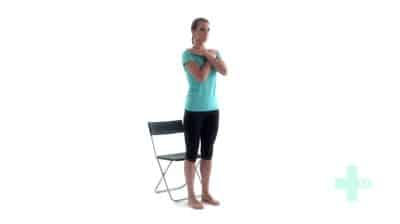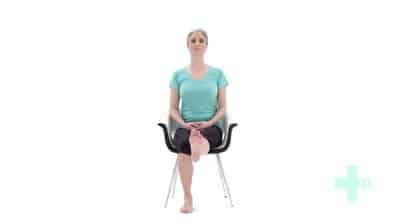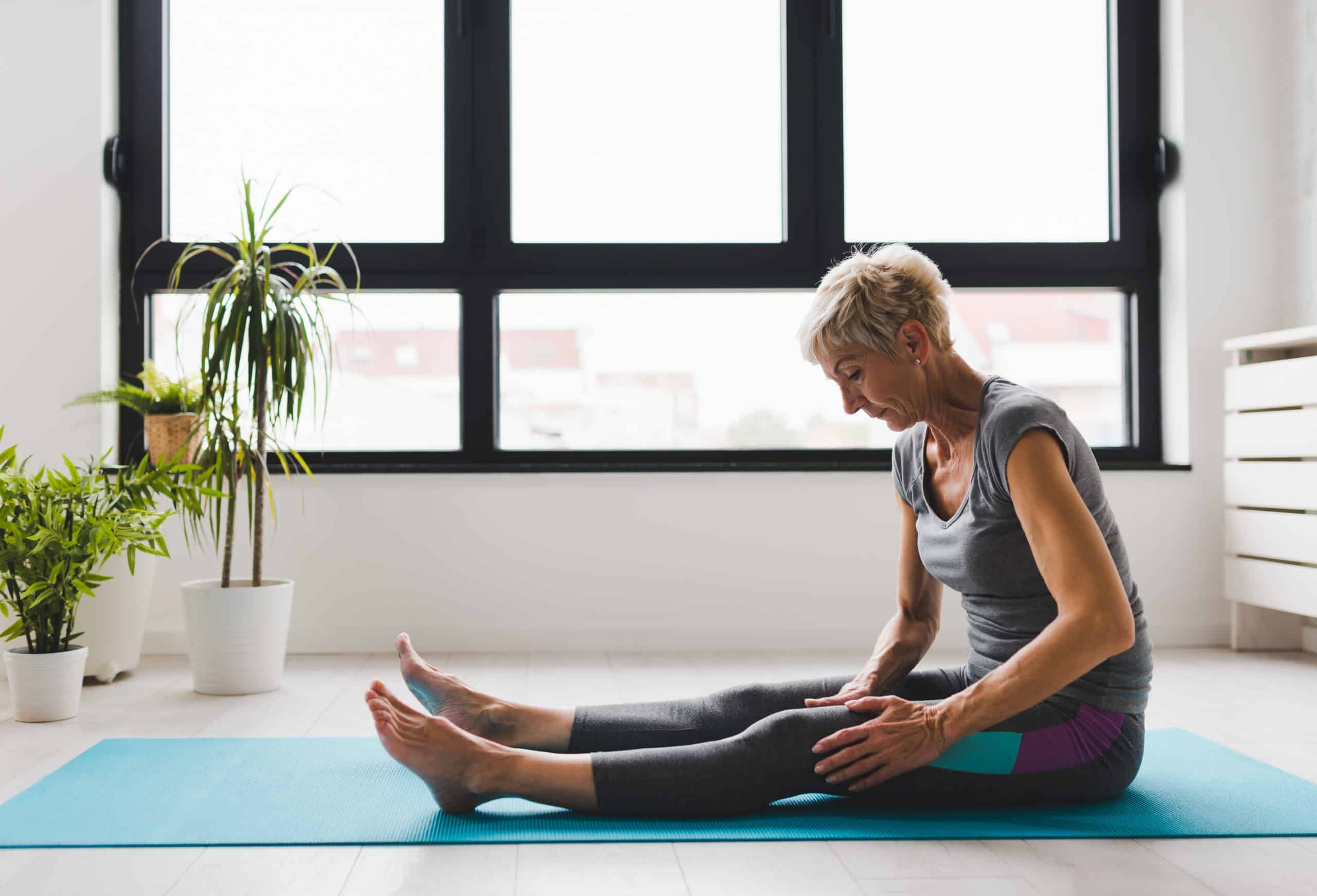Finding the best exercises for knee pain can be tough.
It’s a constant battle between pain, stiffness and constant fatigue.
If you’re like most people with knee pain, it’s hard to know what exercises to do and if it hurts, should you keep going?
Here are our best physiotherapy exercises for knee pain, complete with ways to make them easier or harder to suit everyone.
1) SIT TO STAND

Find a normal sized chair. Bend your knees to 90 degrees. Cross both arms and then lean forward & stand up.
Too Easy? Try a lower chair or try an asymmetric Sit to Stand (bend your knee with pain back further than the other one and repeat the exercise).
Too Hard? Make the seat higher like a stool or some cushions.
Performing a Sit to Stand is the BEST exercise for knee pain (especially for people with osteoarthritis). This knee exercise strengthens your quadriceps muscles which are vital for taking load off your knees and relieving pain.
2) BRIDGE

Bend both your knees back whilst laying on a bed, yoga mat or couch. Push through your heels and lift up your bottom.
Too Easy? Try a single leg bridge or do it with both your feet on a swiss ball.
Too Hard? Begin by just clenching your gluteal muscles or start with just a pre-lift, then build up the exercise from there.
Bridging is a great strengthening exercise for knee pain. As well as strengthening your knees, it also helps exercise your hips, back and core muscles.
3) SLIDER

The standing leg (fixed foot) is for your knee with pain that you are exercising. With a sock on, slide your other foot backwards whilst bending your standing knee. (Keep the weight over your fixed knee). Safety tip: place your hand on a wall or chair beside you for balance.
Too Easy? Try slide your foot out to the side instead of back – keep your weight over your standing knee (don’t starfish).
Too Hard? Only bend your knee a little bit, or don’t use a slider and just practice stepping your knee back.
Sliders are a great whole knee movement. Whilst strengthening your knee, it also helps you work on control of your knee.
4) SEATED KNEE EXTENSION

Sitting in a chair, straighten your painful knee until it’s fully straight. Repeat.
Too Easy? Add a resistance band to your ankle to get a nice burn through your quadriceps.
Too Hard? Don’t straighten your knee fully.
As your quadriceps muscles are vital for reducing your knee pain with exercise by taking load off your painful knee, once you start to add resistance to this exercise, you’ll really start to notice a benefit!
WHAT IF THESE EXERCISES ARE TOO PAINFUL FOR MY KNEE?
Pain with exercise is common with knee osteoarthritis. As long as you keep your pain to mild on a pain scale or 2/10 (10 being really, really painful) you will be fine and more importantly you won’t be doing more damage to your knee or increasing pain in your knee for the next day.
All the above exercises also have options if you are finding it difficult to keep your pain below 2/10. If you can’t do these modified exercises with minimal pain in your knee, just skip it and move on.
DOES EXERCISE MAKE KNEE OSTEOARTHRITIS WORSE?
The answer is an emphatic NO.
In fact, your knee osteoarthritis is more likely to progress (confirmed by MRI) if you don’t exercise than if you do.
See a great article describing Helen’s story below from an SBS news story:
MYTH BUSTED: exercise isn’t harmful for people with knee osteoarthritis
IS WALKING OR RUNNING BAD FOR MY KNEES?
Walking or running is NOT bad for your knees similarly how squatting isn’t bad for your knees.
The exercise guidelines and research on this topic suggest that it is not either walking or running which is bad for your knees but likely how you are introducing (or reintroducing) it into your physical program that’s likely to impact you.
Simply put, if you have always been a runner and you have never stopped, you are fine to continue. If you have never been a runner or you have had a decent break from running ~6 months, then you need to gradually build up your capacity.
The same goes for walking.
Start small: 1-2kms at slow speed, reassess, then increase by 10%.
BUT MY DOCTOR HAS TOLD ME THAT IMPACT EXERCISE IS BAD FOR MY KNEE CARTILAGE
Knee Osteoarthritis is no longer seen as a “wear and tear” condition.
It is now believed that the impact from exercise and the joint loading is what nourishes the joint cartilage affected by osteoarthritis.
This loaded exercise pushes out old synovium fluid from your knee cartilage and allows it to soak up new joint fluid with new nutrients which help restore and repair.
ALTHOUGH: it is likely that too much impact may be the trigger for people with knee pain from osteoarthritis. See: causes of knee osteoarthritis
HOW OFTEN SHOULD I EXERCISE FOR MY KNEE PAIN?
The international guidelines recommend exercising 30 minutes a day most days of the week as well as twice a week for strength training.
Although as loaded exercise for knee pain is good for your joint cartilage, rest and recovery from loaded exercise is just as important.
For example, you may alternate doing the exercises above with exercise that doesn’t involve much impact or weight bearing.
EXAMPLE WEEKLY KNEE PAIN EXERCISE PROGRAM
Monday: Weight bearing exercise involving strengthening for your knees, hips, core and back. 30 minutes.
Tuesday: Aqua aerobics class. 30 minutes
Wednesday: 4-5km walk. Upper body strengthening exercises at gym. 2 x 30 mins
Thursday: Tai Chi class. 40 minutes
Friday: Weight bearing exercise involving strengthening for your knees, hips, core and back. 30 minutes.
Saturday: Aqua aerobics class. 30 minutes
Sunday: Rest day
**Please note: this is an EXAMPLE exercise program and it is not intended for general use or as professional advice. It is always recommended to consult your GP prior to starting an exercise regime.

